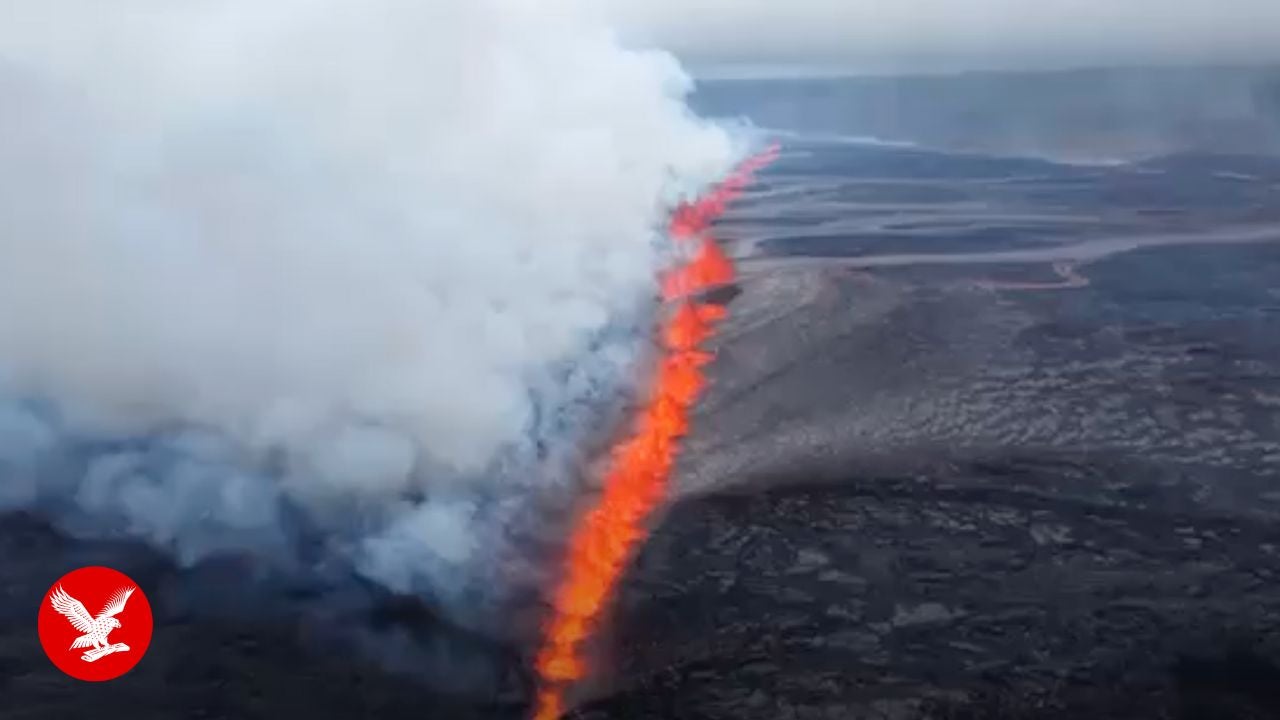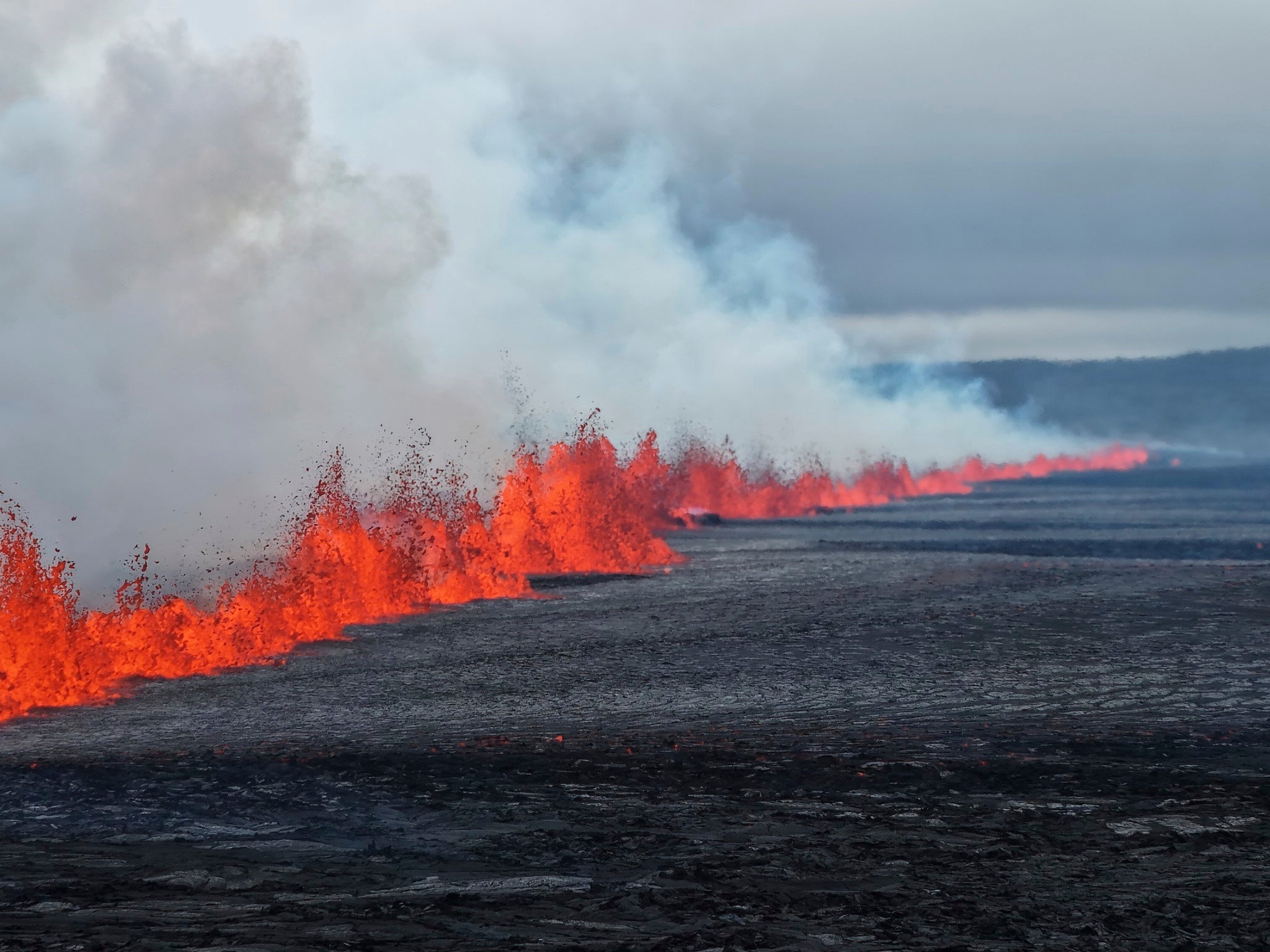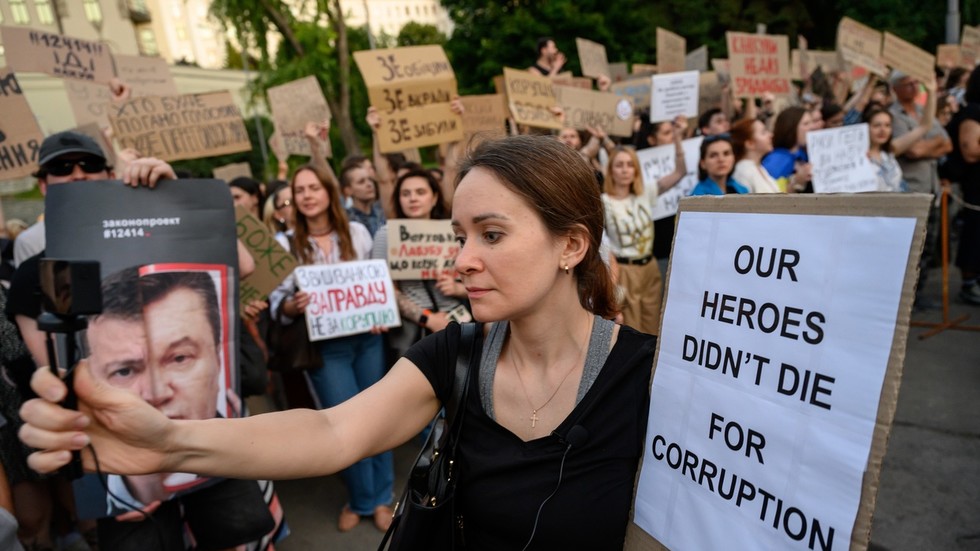The volcanic fissure that opened up in Iceland late on Tuesday has now expanded, and stretches further north than at any time since 2023.
Lava and toxic gas continue to spill from the latest eruption on the Reykjanes Peninsula.
Officials say the crack in the ground measures some 2.4 kilometres, with fresh lava now covering 3.2 square kilometres.
A large sulfur dioxide gas cloud is blowing toward Keflavík International Airport. Authorities have told people nearby to stay indoors and keep their windows shut as pollution levels rise. Despite this, flights are running normally and the airport remains open.
Nearby towns, the popular Blue Lagoon spa, and other tourist sites were evacuated as a safety measure. Grindavík, a town evacuated last year, remains largely empty.
This marks the twelfth eruption in the area since 2021 and is part of a growing sequence of volcanic events on the Reykjanes Peninsula, which began when dormant systems were reactivated after centuries of silence.
Lava flow continues but has decreased in intensity, says IMO
Iceland’s Sundhnúkur crater continued this morning, though officials say there is a slowdown in both lava flows and earthquakes.
The Icelandic Meteorological Office (IMO) said the main fissure, which opened northeast of Stóra Skógfell early yesterday, has elongated and now extends further north than any since late 2023.
Lava is mostly accumulating to the east, spreading across low-lying areas and covering about 3.2 square kilometres according to the latest satellite imagery.
Volcanic tremor and seismic activity have dropped significantly since the initial outburst, with only a few minor quakes recorded per hour.
"The eruption is ongoing, but intensity has declined since this morning," the IMO said in its latest update.
However, hazardous gases and wildfires remain a serious risk for communities on the Reykjanes Peninsula, it said.
High concentrations of sulfur dioxide are being measured over the region, extending westward on strong southeast winds. Residents in towns including Reykjanesbær, Vogar and Sandgerði were warned to keep windows closed, turn off ventilation, and stay indoors during high pollution periods.

Stuti Mishra17 July 2025 07:56
Lava flows from wall of fire during volcanic eruption in Iceland


Stuti Mishra17 July 2025 07:46
Evacuation went smoothly, police say
Police commissioner Margret Palsdottir told AP the evacuation went smoothly and lasted about 90 minutes.
“Of course, people have different opinions on whether the evacuation is necessary, but it is a decision we make and take responsibility for,” she said.
Stuti Mishra17 July 2025 07:12
Recent eruptions in Iceland
Today’s eruption near Sundhnúkur crater is the 12th since volcanic activity reawakened on the Reykjanes Peninsula in 2021, ending nearly 800 years of geological silence in the region.Here’s a quick look at the most recent eruptions in the same system:
- Dec 2023: A powerful fissure eruption near Hagafell led to the first full evacuation of Grindavík and triggered widespread ground deformation.
- Jan 2024: Lava breached defences, destroying homes and killing one person in a ground collapse.
- Feb 2024: A short but intense eruption cut off hot-water pipelines, causing major disruption in the region.
- Mar–May 2024: The longest and most voluminous eruption so far, lasting 54 days and producing 35 million cubic metres of lava.
- May–June 2024: Another eruption followed, keeping the region under continuous alert.
- Nov–Dec 2024: Lava reached the Blue Lagoon car park during a fissure event, prompting mass evacuations once again.
Alexander Butler17 July 2025 03:00
Full story: Iceland volcano erupts opening up 1km-long fissure
A volcano on Iceland’s Reykjanes Peninsulaerupted again on Wednesday, spewing lava and smoke in what officials say is the twelfth eruption in the region since 2021.
The eruption prompted fresh evacuations from the nearby town of Grindavík, a luxury hotel, and the popular Blue Lagoon spa, Icelandicauthorities said.
The Icelandic Meteorological Office (IMO) said magma pushed through the earth’s crust, opening a fissure estimated to be between 700 and 1,000 metres long.
Read more:
Alexander Butler17 July 2025 02:00
Evacuations ordered in Grindavík
The eruption prompted fresh evacuations from the nearby town of Grindavík. However, the town has been almost empty for months.
Authorities first ordered a full evacuation of the town in November 2023 after seismic activity and land deformation signalled a high risk of magma movement beneath the area.
A fissure eruption in December caused structural damage to roads and buildings. Subsequent eruptions in January and February 2024 led to further destruction, including the collapse of homes and the death of one person due to ground cracking.
Although some residents briefly returned during calmer periods, the area has remained largely off-limits.
Alexander Butler17 July 2025 00:01
Evacuations ordered in Grindavík
The eruption prompted fresh evacuations from the nearby town of Grindavík. However, the town has been almost empty for months.
Authorities first ordered a full evacuation of the town in November 2023 after seismic activity and land deformation signalled a high risk of magma movement beneath the area.
A fissure eruption in December caused structural damage to roads and buildings. Subsequent eruptions in January and February 2024 led to further destruction, including the collapse of homes and the death of one person due to ground cracking.
Although some residents briefly returned during calmer periods, the area has remained largely off-limits.
Alexander Butler16 July 2025 23:00
What makes Iceland so volcanically active?
Iceland sits directly on the Mid-Atlantic Ridge, where the North American and Eurasian tectonic plates are pulling apart.
This geological hotspot fuels regular volcanic and seismic activity. The Reykjanes Peninsula, now erupting again, had been dormant for 800 years before reawakening in 2021.
Alexander Butler16 July 2025 22:00
This is what we know so far about the Sundhnúkur eruption in Iceland
- A volcanic eruption began early on Wednesday near Sundhnúkur crater on the Reykjanes Peninsula, southwest Iceland.
- Lava is flowing from a fissure estimated to be 700–1,000 metres long, according to the Icelandic Meteorological Office (IMO).
- Authorities evacuated Grindavík, the nearby Blue Lagoon resort, and surrounding areas as a safety measure.
- No infrastructure has been damaged so far, and there is currently no threat to populated areas.
- The eruption has not affected flights at Keflavík International Airport, operations are continuing as normal.
- This marks the 12th eruption in the Reykjanes region since 2021, part of a prolonged volcanic cycle.
- Experts warn that similar eruptions may continue in the region over the coming months or years.
Alexander Butler16 July 2025 21:00
This is the 12th eruption in the region since 2021
The latest eruption is part of a broader pattern of seismic activity that reawakened the Reykjanes Peninsula in 2021 after centuries of dormancy. Since then, the area has seen repeated volcanic events, with fissure eruptions now becoming a near-annual phenomenon.
Experts say Iceland is now in a new volcanic cycle, with magma expected to keep surfacing in the region for years or even decades.
Alexander Butler16 July 2025 20:00

 1 week ago
7
1 week ago
7









